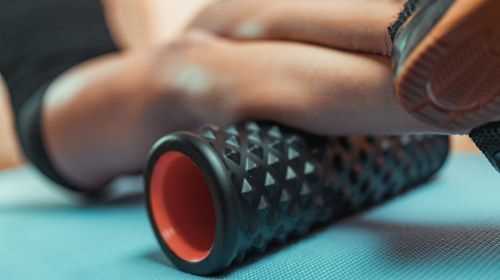For a few years now, fascia has been on everyone’s lips. Because the thin tissue seems to play a role in many pains, for example in the back or in the joints. But what are fasciae anyway and why can they become problematic?
Fasciae can cause more discomfort than you might think. Whether with knee problems, back pain or tension headache: Up until now, doctors have often suspected the cause to be in the muscles. But this knowledge alone has not been able to help those affected so far. Researchers have unmasked the real culprits for pain in the musculoskeletal system: fascia. As connective tissue containing collagen, they envelop every muscle, individual muscle fibers and the body as a whole.
Fascia: network-like tissue made of proteins, water and cells
Nowadays, many medical professionals and researchers use the terms fascia and connective tissue synonymously. It pervades the entire body and has various tasks. Most importantly, however, it keeps all parts of the body in the right places and protects them.
Fasciae are built up like a kind of network, because the fibers contained in the tissue run crossed. Fascia consist of certain cells, fluid and the proteins collagen and elastin. Collagens tend to be firm structures that are only slightly elastic, but are tear-resistant. They keep the body in shape and are mainly found in tendons, ligaments and the sheaths of muscles, kidneys or the pericardium. Elastin, on the other hand, is – as the name suggests – elastic. It can be stretched a lot, but then goes back to its original shape. There is a lot of elastin in the fasciae of the aorta, lungs, (gall) bladder or subcutaneous tissue, for example.
The connective tissue cells, on the other hand, are responsible for the production of collagen and elastin. They also regularly renew the fascia tissue. But that takes time: They only completely replaced the tissue after about two years.
Regular renewal of the fascia fluid necessary
After all, fibers and cells are surrounded by a liquid, the so-called basic substance. It consists of water and hyaluronic acid. The fluid nourishes the fascia and the structures it encases. For this supply, however, it is essential that the basic substance is regularly replaced. This is done by “squeezing out” the fascia through pressure and tension. Then they suck up with new liquid again.
If the basic substance is not renewed regularly, waste products will accumulate there. These make the fasciae less elastic. The tissue removes the metabolic waste via the lymphatic system, which also runs through the entire body. In addition, the basic substance and in particular the hyaluronic acid it contains acts as a lubricant to enable smooth movements.
Three groups: superficial, visceral and deep fascia
In addition to receptors for pain, there are also sensory receptors in the connective tissue. This enables the fascia to react to pressure, temperature and vibrations. They also recognize changes in movement, such as muscle tension or joint position, and the chemical composition of the surrounding tissue.
Depending on the location and task of the fascia, doctors divide them into three groups:
superficial fascia: They lie beneath the skin and represent the connection between organs and tissue. They also envelop blood vessels, nerves and glands.
visceral fascia: They protect the internal organs and keep them in place. Only parts of important organs such as the meninges, pericardium or pleura are covered with visceral fascia.
deep fascia: They envelop individual muscles, muscle groups, bones and joints.
Fasciae have important tasks in the body because they ensure mobility and performance: They provide support with every movement, protect the muscles from injuries and enable the body to move smoothly. Because they transfer the forces of the muscles to the bones and joints and are responsible for the fact that muscles and organs can move against each other, for example during breathing.
Aching fascia due to excessive strain, lack of exercise, stress
Healthy fascia support the organism. But it can also be that the connective tissue is affected by certain influences and becomes more and more slack. One then speaks of connective tissue weakness, which is mostly noticeable on the surface as cellulite. In addition, fasciae can become more and more rigid with increasing age, while at a young age they are still very elastic and flexible. They also suffer from:
- wrong load – the movements are not carried out correctly or only load on one side (e.g. tennis elbow)
- Sedentary lifestyle
- Overload / too much sport
- Injuries
- constant stress
The fluid that is normally passed on with every muscle movement is no longer transported properly – the fascia no longer glides properly. As a result, the basic substance no longer flows, but builds up. The fasciae become matted, sticky, harden or become thin and brittle. Pain and tension mainly occur in the neck, shoulders, back, legs or even the joints. In these cases, fasciae are not only significantly less elastic, but also limit the mobility of those affected.
Fascia training keeps connective tissue healthy
So if you keep the fabric elastic and resistant, you have the best possible protection against a wide range of complaints. If, on the other hand, the fascia network – including its connections to tendons, ligaments and joint capsules – is neglected, sooner or later there will be tension and pain, as well as injuries such as strains.
If you want to prevent pain and injuries, you can do a lot yourself. Whether with a tennis ball, yoga, stretching exercises or a fascia roll: slow, mindful (stretching) movements or springy movements are decisive in fascia training. In the picture gallery there are some tips and exercises for fascia training with a fascia roller.
Strengthen fascia with the right foods and sleep
In addition to exercise, rest and nutrition are also important for healthy fasciae: in order to be able to grow, the connective tissue needs sufficient sleep. During this time, the growth hormone STH is formed, which stimulates collagen synthesis. Chronic lack of sleep can therefore prevent healthy fascia renewal.
Diet and healthy fasciae are also related. In the case of weak connective tissue or sticky fasciae, foods with essential amino acids in particular should end up on the plate.
.

